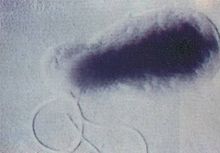Hyphomicrobiales
| Rhizobiales | |
|---|---|

| |
| Bartonella | |
| Scientific classification | |
| Kingdom: | |
| Phylum: | |
| Class: | |
| Order: | Rhizobiales Kuykendall 2006
|
| Families | |
| Synonyms | |
|
Hyphomicrobiales | |
Rhizobiales is an order of alpha proteobacteria. They are Gram-negative.
The rhizobia, which fix nitrogen and are symbiotic with plant roots, appear in several different families. The four families Bradyrhizobiaceae, Hyphomicrobiaceae, Phyllobacteriaceae, and Rhizobiaceae contain at least six genera of nitrogen-fixing, legume-nodulating, microsymbiotic bacteria. Examples are the genera Bradyrhizobium and Rhizobium. Species of Methylocystaceae are methanotrophs; they use methanol (CH3OH) or methane (CH4) as their sole energy and carbon sources. Other important genera are Bartonella (pathogen) and Agrobacterium (genetic engineering).
Phylogeny
The currently accepted taxonomy is based on the List of Prokaryotic names with Standing in Nomenclature[2] and National Center for Biotechnology Information[3] and the phylogeny is based on whole-genome sequences.[4]
| |||||||||||||||||||||||||||||||||||||||||||||||||||||||||||||||||||||||||||||||||||||||||||||||||||||||||||||||||||||||||||||||||||||||||||||||||||||||||||||||||||||||||||||||||||||||||||||||||||||||||||||||||||||||||||||||||||||||||||||||||||||||
Further reading
- Kuykendall, L. D. and Dazzo, F.B. 2005. Allorhizobium. In Brenner, Krieg, Staley and Garrity (Editors), The Alpha-, Beta-, Delta- and Epsilonproteobacteria, The Proteobacteria, Part C, Bergey’s Manual of Systematic Bacteriology, 2nd. Ed., Vol. 2, Springer, New York, NY, pp. 345–346.
- Kuykendall, L. D. 2005 Genus Azorhizobium. In Brenner, Krieg, Staley and Garrity (Editors), The Alpha-, Beta-, Delta- and Epsilonproteobacteria, The Proteobacteria, Part C, Bergey’s Manual of Systematic Bacteriology, 2nd. Ed.,Vol. 2, Springer, New York, NY, pp. 505–506.
- Kuykendall, L.D. 2005. Genus Bradyrhizobium, family Bradyrhizobiaceae. In: Bergey's Manual of Systematic Bacteriology, 2nd Edition, 2nd Volume. George Garrity, (Ed.) Springer–Verlag, New York, NY, pp. 438–443.
- Chen, W. X., E.T. Wang, and L.D. Kuykendall. 2005. Genus Mesorhizobium, Family Photobacteriaceae. In: Bergey's Manual of Systematic Bacteriology, 2nd Edition, 2nd Volume. George Garrity, (Ed.) Springer–Verlag, New York, NY, pp. 403–408.,
- Kuykendall, L.D., J.M. Young, E. Martínez-Romero, A. Kerr, and H. Sawada. 2005. Genus Rhizobium, a highly divergent genus in a revised family, the Rhizobiaceae. In: Bergey's Manual of Systematic Bacteriology, 2nd Edition, 2nd Volume. George Garrity, (Ed.) Springer–Verlag, New York, NY, pp. 324–340.
Notes
- ^ a b These families have been proposed but not yet validly published according to the rules of the Bacteriological Code.
- ^ Pleomorphomonas is currently included in Methylocystaceae.
- ^ Kaistia is currently included in Rhizobiaceae.
- ^ Balneimonas is currently included in Bradyrhizobiaceae.
- ^ Meganema is currently included in Methylobacteriaceae.
References
- ^ a b Beck, D. A. C.; McTaggart, T. L.; Setboonsarng, U.; Vorobev, A.; Goodwin, L.; Shapiro, N.; Woyke, T.; Kalyuzhnaya, M. G.; Lidstrom, M. E.; Chistoserdova, L. (2015). "Multiphyletic origins of methylotrophy in Alphaproteobacteria, exemplified by comparative genomics of Lake Washington isolates". Environmental Microbiology. 17 (3): 547–54. doi:10.1111/1462-2920.12736. PMID 25683159.
- ^ J.P. Euzéby. "Proteobacteria (scroll down for Rhizobiales)". List of Prokaryotic names with Standing in Nomenclature. Retrieved 2012-05-02.
- ^ "Rhizobiales". National Center for Biotechnology Information. Retrieved 2012-05-02.
- ^ Collapsed from the tree built by PATRIC. Access date: 2012-05-02.
